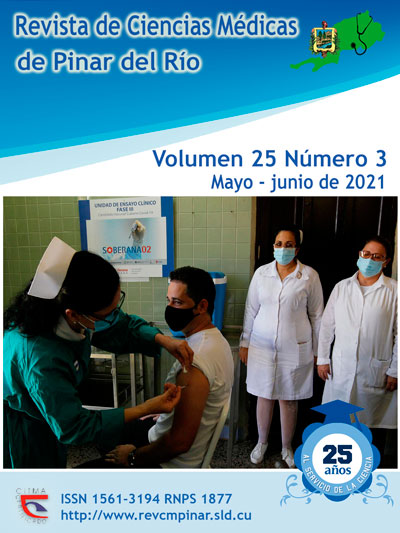Educational intervention in the third-trimester pregnant women to increase the perceived benefits toward breastfeeding
Keywords:
WORLD HEALTH ORGANIZATION, BREAST FEEDING, PRIMARY HEALTH CARE, CHILD, UNITED NATIONS.Abstract
Introduction: breastfeeding constitutes the most important measure to achieve the reduction of morbidity and mortality rates due to infectious diseases in the early stages of life; it provides benefits to the child since birth and facilitates all the nutritional requirements for a healthy and systematic development. To carry out health actions to maintain breastfeeding during the established period, constitutes a priority for the Mother-Child Program.
Objective: to increase the benefits perceived toward breastfeeding in the third-trimester pregnant women admitted the Maternal Care Home of Media Luna municipality, Granma province, during the period September-November 2019.
Methods: a quasi-experimental study with an educational intervention was conducted, having the before-after modality, without a control group and with a group of 40 pregnant women. The theoretical methods applied were: analytical-synthetic and the questionnaire as empirical method. Nonparametric test of significance was the statistical method applied.
Results: the majority of the pregnant women were between 21-25 years old, 62,5 % of them had a senior high-school educational level where those without working links prevailed. Initial evaluation showed low levels of the perceived benefits of breastfeeding (77,5 %) of the pregnant women studied and after the application of the educational program, it was possible to increase the perceived benefits of breastfeeding in the 97,5 % of the participants.
Conclusions: with the implementation of the educational intervention research proposed it was possible to increase the perceived benefits towards breastfeeding in pregnant women.
Downloads
References
1. Soriano Faura FJ, Pallás Alonso CR. Evidencias sobre la promoción de la lactancia materna. En: AEPap (ed.). 17 Congreso de Actualización Pediatría.[Internet] 2020[citado 04/12/2020]. Madrid: Lúa Ediciones 3.0; 2020. p. 205-218. https://www.aepap.org/sites/default/files/documento/archivos-adjuntos/congreso2020/207.evidencias_promocion_lactancia.pdf
2. US Preventive Services Task Force. Primary Care Interventions to Support Breastfeeding: US Preventive Services Task Force Recommendation Statement. JAMA. [Internet] 2016[citado 04/12/2020]; 316(16): 1688–1693. https://jamanetwork.com/journals/jama/article-abstract/2571249
3.Meek JY, Hatcher AJ. The Breastfeeding friendly pediatric office practice. Pediatrics. [Internet] 2017[citado 04/12/2020]; 139(5): e2017064.Disponible en https://pediatrics.aappublications.org/content/pediatrics/139/5/e20170647.full.pdf
4.González MD, Ortiz H, Cañedo-Argüelles C, Esparza MJ, Cortés O, Claramonte M,Ordobás M. Prevalencia de la lactancia materna y factores asociados con el inicio y la duración de la lactancia materna exclusiva en la Comunidad de Madrid entre los participantes en el estudio ELOIN. AnPediatr [Internet]. 2018 [citado: 04/12/2020]; 89(1):32-43.Disponible en: https://www.sciencedirect.com/science/article/pii/S1695403317303144
5. Global strategy for Infant and Young Child Feeding World Health Organization .Geneva. [Internet].2003 [citado: 04/12/2020]:[aprox.3p]. Disponible en: https://www.who.int/nutrition/publications/gs_infant_feeding_text_eng.pdf
6. Ministerio de Salud Pública. Anuario Estadístico de Salud 2016 [Internet] .2017[citado 04/12/2020]:[aprox. 193.p] Disponible en:
7. Àlvarez Caballero M, Orozco Hechavarría N, Moreno Alvarez A, Marín Álvarez T, Tur Vaillant I. Factores que influyeron en el abandono precoz de la lactancia materna en lactantes de un Grupo Básico de Trabajo. Rev Med Electrón [Internet]. 2017 [citado: 04/12/2020]; 39(4): 884-893. Disponible en: http://scielo.sld.cu/scielo.php?script=sci_arttext&pid=S1684-18242017000400004&lng=es
8. Estévez González MD, Martell Cebrían D, Medina Santana R, García Villanueva E, Saavedra Santana P. Factores relacionados con el abandono de la lactancia materna. An Esp Pediatr[Internet].2002[citado: 04/12/2020];56(2):144-50. Disponible en: https://www.sciencedirect.com/science/article/abs/pii/S1695403302789443
9. Delgado Becerra A, Arroyo Cabrales L, Díaz García M, Quezada Salazar C. Prevalencia y causas de abandono de lactancia materna en el alojamiento conjunto de una institución de tercer nivel de atención. Bol Med Hosp InfantMéx[Internet] .2006[citado: 04/12/2020];63(1):31-9.Disponible en: https://www.medigraphic.com/cgi-bin/new/resumen.cgi?IDARTICULO=8545
10.Ruiz Silva M, Pouymiró Brooks Y, Dumas Nicó Y. Lactancia materna exclusiva a menores de seis meses pertenecientes al Policlínico Docente Municipal de Santiago de Cuba. MEDISAN [Internet].2014 [citado: 04/12/2020]; 18(2): 226-234. Disponible en: http://scielo.sld.cu/scielo.php?script=sci_arttext&pid=S1029-30192014000200012&lng=es
11.Guerra-Domínguez E, Martínez-Guerra M, Arias-Ortiz Y, Luis-Fonseca R, Martínez-Jiménez A. Impacto de estrategia educativa sobre lactancia materna a futuras madres2005-2016. MULTIMED [Internet]. 2017 [citado: 04/12/2020]; 21(2):[aprox. 15 p.]. Disponible en: http://www.revmultimed.sld.cu/index.php/mtm/article/view/487
12. Niño MR, Silva EG, Atalah SE. Factores asociados a la lactancia materna exclusiva. RevChilPediatr [Internet].2012 [citado: 04/12/2020];83(2):161-9. Disponible en: https://scielo.conicyt.cl/scielo.php?pid=S0370-41062012000200007&script=sci_arttext&tlng=e
13. Gorrita Pérez R, Terrazas Saldaña A, Brito Linares D, Ravelo Rodríguez Y.Algunos aspectos relacionados con la lactancia materna exclusiva en los primeros seis meses de vida. Rev Cubana Pediatr [Internet]. 2015 [citado: 04/12/2020]; 87(3): 285-297. Disponible en: http://scielo.sld.cu/scielo.php?script=sci_arttext&pid=S0034-75312015000300004&lng=es
14.Rivera Ledesma E, Bauta León R, Fornaris Hernández A, Flores Martínez M, Pérez Majendie R. Factores determinantes de la lactancia materna exclusiva: Policlínico "Aleida Fernández". Revhabanciencméd [Internet]. 2017 [citado: 04/12/2020]; 16(6): 879-890. Disponible en: http://scielo.sld.cu/scielo.php?script=sci_arttext&pid=S1729-519X2017000600005&lng=es
15. Gil-Estevan M, Solano-Ruíz M. Diversidad cultural y lactancia materna: prestación de cuidados culturalmente competentes en Atención Primaria. IndexEnferm [Internet]. 2017 [citado: 04/12/2020]; 26(3):162-165. Disponible en: https://scielo.isciii.es/scielo.php?script=sci_arttext&pid=S1132-12962017000200009&lng=es
Downloads
Published
How to Cite
Issue
Section
License
Authors who have publications with this journal agree to the following terms: Authors will retain their copyrights and grant the journal the right of first publication of their work, which will be publication of their work, which will be simultaneously subject to the Creative Commons Attribution License (CC-BY-NC 4.0) that allows third parties to share the work as long as its author and first publication in this journal are indicated.
Authors may adopt other non-exclusive license agreements for distribution of the published version of the work (e.g.: deposit it in an institutional telematic archive or publish it in a volume). Likewise, and according to the recommendations of the Medical Sciences Editorial (ECIMED), authors must declare in each article their contribution according to the CRediT taxonomy (contributor roles). This taxonomy includes 14 roles, which can be used to represent the tasks typically performed by contributors in scientific academic production. It should be consulted in monograph) whenever initial publication in this journal is indicated. Authors are allowed and encouraged to disseminate their work through the Internet (e.g., in institutional telematic archives or on their web page) before and during the submission process, which may produce interesting exchanges and increase citations of the published work. (See The effect of open access). https://casrai.org/credit/



